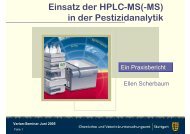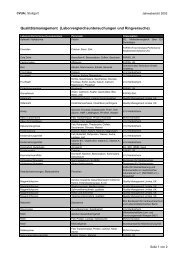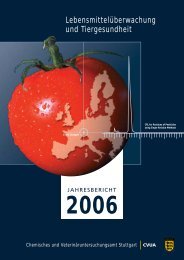New Developments in QuEChERS methodology
New Developments in QuEChERS methodology
New Developments in QuEChERS methodology
You also want an ePaper? Increase the reach of your titles
YUMPU automatically turns print PDFs into web optimized ePapers that Google loves.
<strong>New</strong> <strong>Developments</strong> <strong>in</strong><br />
<strong>QuEChERS</strong> <strong>methodology</strong><br />
EPRW 2006, Corfu<br />
Slide 1<br />
Michelangelo Anastassiades<br />
Bünyam<strong>in</strong> Tasdelen<br />
Ellen Scherbaum<br />
Stuttgart Chemical and Veter<strong>in</strong>ary Control Laboratory
EPRW 2006, Corfu<br />
Slide 2<br />
Introduction, Orig<strong>in</strong>al <strong>QuEChERS</strong><br />
Modifications to broaden analyte spectrum<br />
Modified <strong>QuEChERS</strong><br />
Modifications to broaden matrix spectrum<br />
Results from method validation<br />
Results from EU-PT 6 + 7<br />
Summary<br />
Outl<strong>in</strong>e
<strong>QuEChERS</strong>:<br />
•Quick<br />
•Easy<br />
•Cheap<br />
•Effective<br />
•Rugged<br />
•Safe<br />
EPRW 2006, Corfu<br />
Slide 3<br />
Introduction<br />
Was first <strong>in</strong>troduced at the EPRW 2002 <strong>in</strong><br />
Rome and published <strong>in</strong> 2003 as<br />
“Fast and Easy Multiresidue Method<br />
Employ<strong>in</strong>g Acetonitrile Extraction/Partition<strong>in</strong>g<br />
and “Dispersive SPE” for the Determ<strong>in</strong>ation of<br />
Pesticide Residues <strong>in</strong> Produce“<br />
M. Anastassiades, S.J. Lehotay, D. Štajnbaher,<br />
F.J. Schenck, J. AOAC Int., 86 (2) 412-431, 2003
Orig<strong>in</strong>al <strong>QuEChERS</strong>-Method<br />
Weigh 10 g of Sample (50 mL Teflon-Tube)<br />
EPRW 2006, Corfu<br />
Slide 4<br />
Add 10 mL Acetonitrile<br />
Add ISTD-Solution<br />
Shake Vigorously 1 m<strong>in</strong><br />
Add 4 g MgSO 4 and 1 g NaCl<br />
GC-MSD and LC-MS<br />
Shake Vigorously 1 m<strong>in</strong><br />
Shake 30 s and Centrifuge<br />
Take Aliquot and Mix with MgSO 4 and PSA<br />
Shake Vigorously 30 s<br />
and Centrifuge<br />
Anastassiades et al.<br />
J. AOAC Int.<br />
86 (2) 412-431
EPRW 2006, Corfu<br />
Slide 5<br />
Analyte and Matrix Spectrum<br />
The orig<strong>in</strong>al <strong>QuEChERS</strong><br />
covers a broad analyte spectrum<br />
rang<strong>in</strong>g from the unpolar<br />
to the very polar end<br />
-2,6<br />
Propamocarb (pH4)<br />
-1,8<br />
Clopyralid (pH5)<br />
-0,9<br />
Acephat<br />
-0,4<br />
Oxamyl<br />
0,1<br />
Methomyl<br />
0,2<br />
2,4-D (pH 5)<br />
0,6<br />
Cymoxanil (pH5)<br />
0,8<br />
Acetamiprid<br />
1,0<br />
Kasugamyc<strong>in</strong><br />
1,2<br />
Aldicarb<br />
1,4<br />
Ofurace<br />
1,7<br />
Pirimicarb<br />
The orig<strong>in</strong>al method<br />
was developed for fruit and vegetables<br />
2,1<br />
Dichlorvos<br />
3,0<br />
Iprodion<br />
4,0<br />
Sp<strong>in</strong>osad<br />
5,0<br />
Tebufenpyrad<br />
6,0<br />
Fenpropathr<strong>in</strong><br />
7,0<br />
Etofenprox
EPRW 2006, Corfu<br />
Slide 6<br />
Broaden Analyte Spectrum<br />
Some pesticides are sensitive to pH<br />
Some get ionized at certa<strong>in</strong> pH-values<br />
Acids: HX � H + + X -<br />
Bases: B + H + � BH +<br />
� Ionic form prefers to stay <strong>in</strong> the waterphase<br />
pH-Range of agricultural samples: ~2.5 – 7
Ionizable Compounds - Basic Pesticides<br />
Matrix: apple; fortif. level: 0.1 mg/kg; analysis: LC/MS; ESI (+)<br />
Propamocarb<br />
Thiabendazole<br />
Carbendazim<br />
Fenpropimorph<br />
Spiroxam<strong>in</strong>e<br />
EPRW 2006, Corfu<br />
Slide 7<br />
Imazalil<br />
Prochloraz<br />
pKa of corresp. acid 9.5<br />
pKa of corresp. acid 6.5<br />
pKa of corresp. acid 3.8<br />
pKa of corresp. acid 4.7<br />
pKa of corresp. acid 4.2<br />
pKa of corresp. acid 6.9<br />
pKa of corresp. acid 7.0<br />
0 20 40 60 80 100 120<br />
Recovery %<br />
pH 2.9
Ionizable Compounds - Acidic Pesticides<br />
LC-MS/MS, ESI (-), No PSA Cleanup<br />
EPRW 2006, Corfu<br />
Slide 8<br />
Recovery %<br />
Imazapyr<br />
Clopyralid<br />
Picloram<br />
Benazol<strong>in</strong><br />
4-CPA<br />
Imazethapyr<br />
Dicamba<br />
MCPA<br />
2,4-D<br />
pH5.5<br />
Imazaqu<strong>in</strong><br />
Naphthylacetic acid<br />
Fluoxypyr<br />
2,4,5-T<br />
Mecoprop<br />
Triclopyr<br />
2,4,5-TP<br />
Lower pKa values General Trend Higher pKa values<br />
2,4-DP<br />
Propyzamid<br />
Ioxynil<br />
Bentazon<br />
Bromoxynil<br />
Fluazifop<br />
Bromacil<br />
2,4-DB<br />
MCPB<br />
pH 6<br />
pH 5<br />
pH 4<br />
120<br />
100<br />
80<br />
60<br />
40<br />
20<br />
0<br />
pH 3
pH-Labile Compounds<br />
EPRW 2006, Corfu<br />
Slide 9<br />
Some Pesticides are sensitive to pH<br />
and degrade at high or low pH-values<br />
• In the sample (dur<strong>in</strong>g process<strong>in</strong>g and storage)<br />
� Keep low temperatures<br />
• Dur<strong>in</strong>g sample preparation<br />
� Work fast, adjust pH<br />
• In the extract dur<strong>in</strong>g storage (1 week is common)<br />
� Keep low temperatures, adjust pH,<br />
after dispersive SPE with PSA, pH may reach values exceed<strong>in</strong>g 8
Optimal pH for <strong>QuEChERS</strong> ?<br />
Goals:<br />
• Still good extraction for the most strong acids<br />
• Still good protection for base-sensitives<br />
EPRW 2006, Corfu<br />
Slide 10<br />
tolylfluanid, dichlofluanid, captan, folpet,<br />
dicofol, pyridate…<br />
•Still good protection for acid-sensitives<br />
sulfonylureas, pymetroz<strong>in</strong>e, carbosulfan,<br />
dioxacarb...<br />
Extraction<br />
Extract<br />
storage
Optimal pH for <strong>QuEChERS</strong> ?<br />
pH adjustment before extraction (Buffer<strong>in</strong>g)<br />
1) Buffer<strong>in</strong>g to pH of ~6, Lehotay et al. with acetate buffer<br />
� good recovery for pymetroz<strong>in</strong>e<br />
� Low recoveries for some acidic pesticides<br />
� PSA cleanup is much less efficient<br />
2) Buffer<strong>in</strong>g to pH of 5 to 5.5, citrate buffer,<br />
EPRW 2006, Corfu<br />
Slide 11<br />
• 4 g Magnesium sulphate anhydrous,<br />
• 1 g Sodium chloride,<br />
• 1 g Trisodium citrate dihydrate and<br />
• 0.5 g Disodium hydrogencitrate sesquihydrate
EPRW 2006, Corfu<br />
Slide 12<br />
Portion<strong>in</strong>g of sorbents and salts<br />
Rapid and Easy
Optimal pH for <strong>QuEChERS</strong> ?<br />
pH adjustment after cleanup<br />
Use of formic acid <strong>in</strong> acetonitrile to achieve a “pH” of 5<br />
Base-labile compounds are stabilized:<br />
tolylfluanid,<br />
dichlofluanid,<br />
captan,<br />
Rec. %<br />
100<br />
90<br />
80<br />
70<br />
Tolylfluanid extract stability<br />
7 days<br />
13 days<br />
folpet,<br />
60<br />
50<br />
dicofol,<br />
40<br />
30<br />
pyridate<br />
20<br />
5% formic acid: 10 µL/mL<br />
EPRW 2006, Corfu<br />
Slide 13<br />
10<br />
0<br />
pH 4 pH 5 pH 6 pH 7 pH 8 pH 9 MeCN<br />
Measured pH <strong>in</strong> extract
Sulfonylureas,<br />
Carbosulfan<br />
acid labile...<br />
Rec. <strong>in</strong> %<br />
120<br />
100<br />
80<br />
60<br />
40<br />
20<br />
0<br />
EPRW 2006, Corfu<br />
Slide 14<br />
7 days<br />
13 days<br />
Primisulfuron-Methyl<br />
pH 4 pH 5 pH 6 pH 7 pH 8 pH 9 MeCN<br />
Measured pH of extract<br />
If these<br />
compounds are<br />
<strong>in</strong>cluded <strong>in</strong> the<br />
target spectrum<br />
use an aliquot of<br />
the f<strong>in</strong>al extract<br />
before acidify<strong>in</strong>g
Alox N Supelco, C18<br />
C8-Varian, C8-Am<strong>in</strong>o 50mg<br />
C8/SAX, ENVI-18<br />
Polymeric Strata x, PSA Varian<br />
Si-PFP, Strata NH2<br />
Strata polym. w. Anion, Waters Wax cc6<br />
Si-Triam<strong>in</strong>e, Si-Diam<strong>in</strong>e<br />
H2O Phobic WA-DVB Speedisk, Si-Am<strong>in</strong>e<br />
NH2 Am<strong>in</strong>o Speedisk, Si-Dimethylam<strong>in</strong>e<br />
C8-Am<strong>in</strong>o25, Strata Screen-A<br />
Diam<strong>in</strong>o MN, UP60-50NH2 <strong>in</strong>terchrom<br />
1,2,Am<strong>in</strong>o Bakerbond, Am<strong>in</strong>o SPE J.T.Baker<br />
Alox Aldrich, Am<strong>in</strong>opropyl modif. MN<br />
Alum<strong>in</strong>a-B Supelclean, Alox Aldrich acidic<br />
DEA Varian, Alox N MN<br />
Alum<strong>in</strong>a A Supelclean, Dimethylam<strong>in</strong>o modif. MN<br />
LiChrolut Sax, PA Chromabond<br />
DPA-6S, PF-AEV <strong>in</strong>terchrom<br />
DSC-MCAX, Cation mixed-mode polym. Strata<br />
PCA MN, PH Varian ...<br />
EPRW 2006, Corfu<br />
Slide 15<br />
Improved cleanup<br />
For samples, with a high content<br />
of carot<strong>in</strong>oides<br />
or chlorophyll<br />
cleanup with PSA<br />
is not satisfy<strong>in</strong>g.....<br />
We tested more than 50 SPE sorbents!
EPRW 2006, Corfu<br />
Slide 16<br />
Improved cleanup<br />
GCB, Graphitized Carbon Black, was best <strong>in</strong> handl<strong>in</strong>g and effect<br />
Some pesticides have a high aff<strong>in</strong>ity towards GCB<br />
e.g. hexachlorobenzene, chlorothalonil, thiabendazole<br />
Anthracene may be used as<br />
surrogate QC standard.<br />
Recoveries > 70% will <strong>in</strong>dicate that no<br />
unacceptable losses of pesticides<br />
have occurred.<br />
Lettuce Extract<br />
PSA GCB
EPRW 2006, Corfu<br />
Slide 17<br />
Improved cleanup<br />
The cleanup time (shak<strong>in</strong>g) is<br />
extended from 30 s to 2 m<strong>in</strong>,<br />
Pre-mixtures of MgSO 4 and GCB<br />
facilitates weigh<strong>in</strong>g<br />
Dispersive SPE is performed us<strong>in</strong>g<br />
a comb<strong>in</strong>ation of PSA and GCB<br />
F<strong>in</strong>al extract should rema<strong>in</strong> slightly coloured<br />
PSA GCB
EPRW 2006, Corfu<br />
Slide 18<br />
Weigh 10 g of Frozen Sample<br />
Add 10 mL Acetonitrile<br />
Add ISTD-Solution<br />
Shake<br />
Add 4 g MgSO 4 / 1 g NaCl /<br />
Buffered to pH 5-5.5 with Citrate Buffer<br />
Shake & Centrifuge<br />
Mix an Aliquot with MgSO4 & PSA/(GCB)<br />
Shake & Centrifuge<br />
Acidify extract to pH ~5<br />
to protect base-sensitive pesticides<br />
Optionally: Add other “Analyte Protectants”<br />
Optionally:<br />
Acidic Pesticides LC-MS<br />
Optionally:<br />
SUs LC-MS<br />
<strong>QuEChERS</strong><br />
Multiresidue Analysis<br />
by GC-MS, LC-MS ...
EPRW 2006, Corfu<br />
Slide 19<br />
Broaden matrix spectrum<br />
Dry commodities (cereals, dried fruits) Fatty Commodities
EPRW 2006, Corfu<br />
Slide 20<br />
Broaden matrix spectrum –<br />
E.g. cereals, dried fruits<br />
Dry Commodities<br />
require the addition of water prior to extraction<br />
to weaken <strong>in</strong>teractions of pesticides with the<br />
matrix and to ensure adequate partition<strong>in</strong>g.<br />
Weigh 5 g of sample add 10 mL water....<br />
Remove co-extracted fat by freez<strong>in</strong>g out or C18, if<br />
necessary....
Sample type<br />
Cereals<br />
Dried fruits<br />
Fruit/Vegetables<br />
(water >80 %)<br />
Fruit/Vegetables<br />
(water 30-80 %)<br />
Honey<br />
Spices<br />
EPRW 2006, Corfu<br />
Slide 21<br />
Dry Commodities<br />
Weigh<br />
5 g<br />
5 g<br />
10 g<br />
10 g<br />
5 g<br />
2 g<br />
Water<br />
10 g<br />
7.5 g<br />
-<br />
X g<br />
10 g<br />
10 g<br />
Annotation<br />
Add water to<br />
comm<strong>in</strong>ute, weigh<br />
12.5 g of homogenate<br />
X = 10 g – water<br />
amount <strong>in</strong> 10 g sample
EPRW 2006, Corfu<br />
Slide 22<br />
Broaden matrix spectrum –<br />
Fatty commodities<br />
Commodities with a high lipid load, such as<br />
avocados or plant oils can be employed.<br />
Problems:<br />
�Highly non-polar pesticides<br />
may give recoveries < 70% (e.g. HCB and DDT)<br />
�Co-extracted lipids have to be removed<br />
prior to GC-analysis
Removal of co-extracted lipids<br />
Extractives [mg/ml]<br />
5<br />
4<br />
3<br />
2<br />
1<br />
0<br />
EPRW 2006, Corfu<br />
Slide 23<br />
4,20<br />
raw extract<br />
4,03<br />
PSA<br />
1,48<br />
freez<strong>in</strong>g out<br />
1,33 1,25 1,23 1,15 1,10<br />
C18<br />
PSA/freez<strong>in</strong>g out<br />
C18/freez<strong>in</strong>g out<br />
PSA/C18<br />
PSA/C18/freez<strong>in</strong>g out
100<br />
75<br />
50<br />
25<br />
0<br />
EPRW 2006, Corfu<br />
Slide 24<br />
BS138<br />
Recoveries for oil matrix<br />
Hexachlorobenzene<br />
p,p' -DDE<br />
Dieldr<strong>in</strong><br />
Endosulfan<br />
HCH, gamma-<br />
Chlorpyriphos-methyl<br />
Carbaryl<br />
Chlorpyriphos<br />
Fenthion<br />
Pirimiphos-methyl<br />
Diaz<strong>in</strong>on<br />
TPP<br />
Triflural<strong>in</strong><br />
Deltamethr<strong>in</strong><br />
Malathion<br />
Cypermethr<strong>in</strong><br />
1g<br />
2g<br />
3g
100<br />
75<br />
50<br />
25<br />
0<br />
EPRW 2006, Corfu<br />
Slide 25<br />
BS138<br />
Recoveries for oil matrix<br />
PCB 138 or 153 may be used as<br />
surrogate QC standards<br />
Hexachlorobenzene<br />
p,p' -DDE<br />
Dieldr<strong>in</strong><br />
Endosulfan<br />
HCH, gamma-<br />
Chlorpyriphos-methyl<br />
Carbaryl<br />
Chlorpyriphos<br />
Recoveries > 70% will <strong>in</strong>dicate that no unacceptable<br />
losses of pesticides have occurred.<br />
Fenthion<br />
Pirimiphos-methyl<br />
Diaz<strong>in</strong>on<br />
TPP<br />
Triflural<strong>in</strong><br />
Deltamethr<strong>in</strong><br />
Malathion<br />
Cypermethr<strong>in</strong><br />
1g<br />
2g<br />
3g
EPRW 2006, Corfu<br />
Slide 26<br />
Interlaboratory Validation<br />
3 Validation studies were performed <strong>in</strong> 2005 and 2006 <strong>in</strong><br />
Germany<br />
Thanks to:<br />
Dr. Lutz Alder Berl<strong>in</strong>, PeterBaumann Dortmund, Dr. Sab<strong>in</strong>e<br />
Bracht Münster, Dr. Franz Haslbeck Pfaffenhofen, Dr.<br />
Matthias He<strong>in</strong>zler Kassel, Dr. Günther Kempe Chemnitz,<br />
Labor Specht Hamburg, Dr. Jürgen Lip<strong>in</strong>ski Berl<strong>in</strong>, Dr. Peter<br />
Seulen Kiel, Dr. Magnus Jezussek Erlangen, Dr. Iris Suckrau<br />
Oldenburg, Dr. Harald Kubel Potsdam, Anja Bostel Stuttgart,<br />
Dr. Norbert Reichert Taunusste<strong>in</strong>, Dr. Graf Rostock
GC-MS and LC-MS/MS Inter-Laboratory Validation Study (GDCh)<br />
EPRW 2006, Corfu<br />
Slide 27<br />
GC<br />
LC (+)<br />
LC (-)<br />
Mean recovery, all laboratories, all analytes<br />
101% 100% 105% 102% 100% 100%<br />
Apple Lettuce Orange
GC-MS and LC-MS/MS Inter-Laboratory Validation Study (GDCh)<br />
EPRW 2006, Corfu<br />
Slide 28<br />
GC<br />
LC (+)<br />
LC (-)<br />
Mean RSD %, all laboratories, all analytes<br />
3% 4% 8% 9% 5% 3%<br />
Apple Lettuce Orange
LC-MS/MS Inter-Laboratory Validation Study (BLAPS-Work<strong>in</strong>g Group)<br />
EPRW 2006, Corfu<br />
Slide 29<br />
Mean recovery, all laboratories, all analytes<br />
97% 97% 98% 98% 96% 98% 95% 97%<br />
Cucumber Lemon Wheat Rais<strong>in</strong>s<br />
Ethiofencarb<br />
was oxidized<br />
<strong>in</strong> cucumber<br />
SUs degraded<br />
<strong>in</strong> acidified extract
LC-MS/MS Inter-Laboratory Validation Study (BLAPS-Work<strong>in</strong>g Group II)<br />
Acids, lost <strong>in</strong><br />
PSA cleanup<br />
EPRW 2006, Corfu<br />
Slide 30<br />
Mean recovery, all laboratories, all analytes<br />
101% 98% 99% 94% 100% 101% 100% 97%<br />
Cucumber Lemon Wheat Rais<strong>in</strong>s<br />
Oxidation<br />
Degraded <strong>in</strong> the standard<br />
solution provided
EU - Proficiency Test 6 and 7<br />
EU-PT 6, Tomates (mg/kg)<br />
Pesticide<br />
Acr<strong>in</strong>athr<strong>in</strong><br />
Azoxystrob<strong>in</strong><br />
Bromopropylate<br />
Chlorothalonil<br />
Diaz<strong>in</strong>on<br />
Dimethoate<br />
Endosulfan<br />
Imazalil<br />
Imidacloprid<br />
Oxydemeton-me<br />
Procymidone<br />
Thiabendazole<br />
EPRW 2006, Corfu<br />
Slide 31<br />
CVUA S<br />
<strong>QuEChERS</strong><br />
0.2<br />
0.23<br />
0.46<br />
2.2<br />
4.4<br />
0.13<br />
0.31<br />
0.16<br />
0.23<br />
0.24<br />
0.41<br />
0.33<br />
No. 4<br />
Median<br />
(n=130)<br />
0.284<br />
0.225<br />
0.490<br />
1.626<br />
3.955<br />
0.132<br />
0.344<br />
0.167<br />
0.232<br />
0.199<br />
0.412<br />
0.330<br />
No. 1<br />
EU-PT 7, Grapes (mg/kg)<br />
Pesticide<br />
Acetamiprid<br />
Carbaryl<br />
Cyprod<strong>in</strong>il<br />
Diaz<strong>in</strong>on<br />
Dimethoate<br />
Fenhexamid<br />
Fludioxonil<br />
Imidacloprid<br />
Iprodione<br />
Kresoxim-me<br />
Methomyl<br />
Monocrotophos<br />
Procymidone<br />
Pyrimethanil<br />
Tetraconazole<br />
Thiabendazole<br />
CVUA S<br />
<strong>QuEChERS</strong><br />
0.324<br />
1.68<br />
0.472<br />
0.318<br />
0.144<br />
0.772<br />
0.242<br />
0.598<br />
0.538<br />
0.502<br />
0.153<br />
0.761<br />
1.98<br />
0.148<br />
0.076<br />
0.745<br />
Median<br />
(n=128)<br />
0.312<br />
1.62<br />
0.437<br />
0.287<br />
0.139<br />
0.706<br />
0.238<br />
0.549<br />
0.524<br />
0.453<br />
0.167<br />
0.643<br />
1.90<br />
0.149<br />
0.064<br />
0.656
www.<strong>QuEChERS</strong>.com<br />
EPRW 2006, Corfu<br />
Slide 32<br />
....the modified <strong>QuEChERS</strong> method<br />
<strong>in</strong>clud<strong>in</strong>g all presented modifications<br />
and a lot of background <strong>in</strong>formation is<br />
available via the <strong>in</strong>ternet, as well as the<br />
validation data.<br />
www.quechers.com
Thank you for your attention!<br />
....and the CVUA-Team for their dedicated work and their support!<br />
EPRW 2006, Corfu<br />
Slide 33











